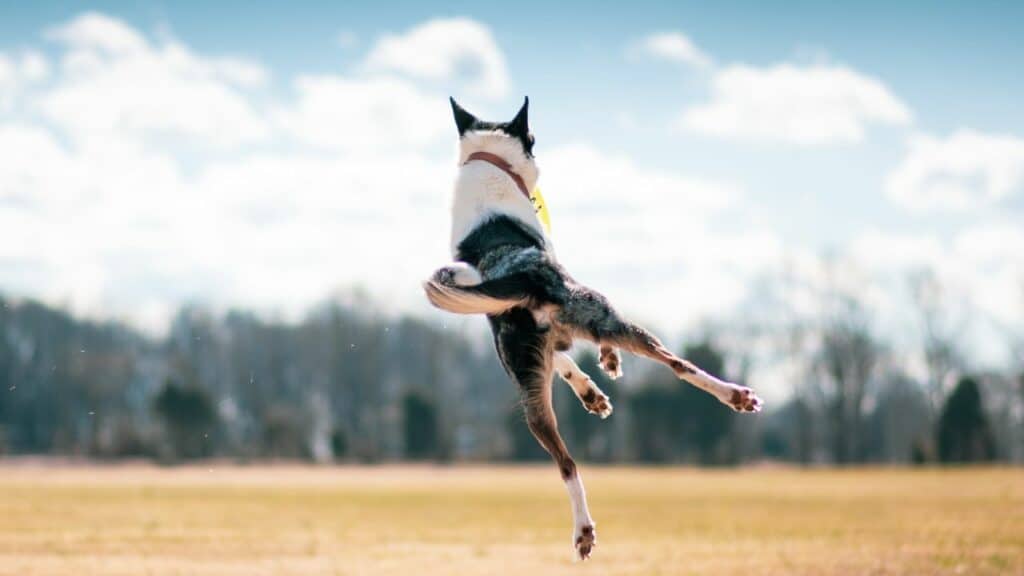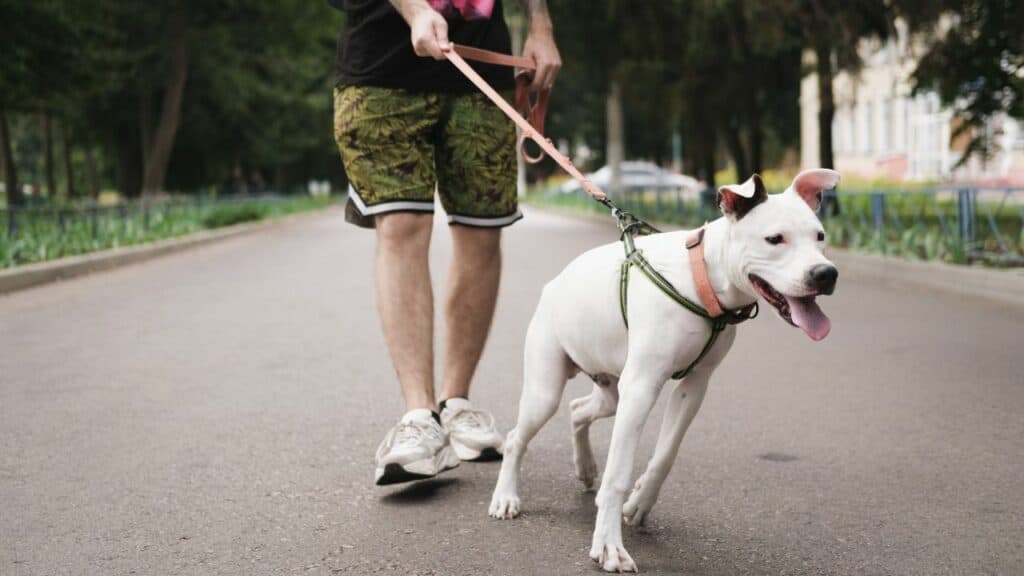Do you have a furry friend that seems to be displaying odd behavior?
From excessive barking to destructive chewing, behavioral issues can run the gamut regarding our dogs.
There are many dog habits that are intuitive to them and may become an issue for pet owners, whether it’s an inconvenience or even dangerous.
Understanding why dogs exhibit certain behaviors is key to learning how best to manage or correct them.
In this article, we share 13 behavioral problems in dogs you need to know and tell you what you can do about each of them.
Biting

Biting is one of the most common behavioral problems in domesticated dogs, especially puppies.
It can range from mildly nipping to serious biting and is usually exhibited when dogs feel scared or threatened.
To address this problem, dog owners must understand why their dogs might bite.
Some possible causes could include a lack of socialization, a bad experience such as being hit or scolded, inappropriate or unrelenting play or training techniques, or an underlying medical issue causing pain.
To address the problem behaviorally, dog owners need to provide their pets with positive reinforcement training methods.
They should also pay close attention to body language.
That way they can recognize signs of fear or other emotions that may prompt biting before it happens.
Additionally, stressed dogs should be given appropriate outlets for energy through exercise and playtime.
By understanding the cause and making conscious efforts to prevent biting incidents from occurring, dog owners can help mitigate behavior issues with their furry friends.
Related: How To Stop My Dog From Biting When Excited
Destructive Chewing
Dogs often chew out of boredom, anxiety, or even just because they find it enjoyable.
Dog owners can usually solve this problem by giving their dog enough toys and ways to burn off energy, and then praising their dog when it acts in a better way.
Make sure your puppy can’t get to anything that could hurt him or her, or block off areas where he or she likes to chew on things that don’t belong to him or her.
If your dog keeps chewing things that shouldn’t be chewed, you should always talk to a professional about how to solve the problem in a safe and effective way.
Begging

Begging can come in many forms, such as putting its feet on a person to get attention
and food, pawing at skin or clothes, jumping on furniture, whining or barking persistently, and more.
It can be an annoying behavior that many pet owners would like to rid their household of once and for all.
To do this successfully, the dog should first be trained not to beg for food.
The owner must encourage them to leave the table during mealtime using positive reinforcement rather than scolding them.
It’s also important to not give puppies treats or other snacks when they beg. Instead, puppies should only get food from their bowl when they are calm.
This will eventually teach them that when they are actively begging, they can’t expect anything from their owners.
Jumping
Dogs jump on people and objects for a variety of reasons.
Sometimes they do it to get attention or to greet someone.
Other times they are simply excited and trying to show their enthusiasm.
Whatever the reason, jumping is still problematic and can lead to accidental injuries or make visitors uncomfortable.
Fortunately, there are ways that pet owners can address this issue.
Teaching “sit” as a command is one of the most effective words in avoiding problem behaviors like jumping.
Setting limits will help reinforce good habits and discourage bad ones, like jumping.
Also, pet owners should ignore bad behavior like jumping on them.

Hyperactivity
That problem occurs when a dog does not have adequate exercise and mental and emotional stimulation.
Typical signs of hyperactivity include excessive barking, restlessness, pacing, destructive behavior, and heightened excitement around people or other animals.
In addition to providing ample exercise for your pooch, there are also other methods for helping diminish the effects of hyperactivity, such as behavior modification games, introducing calming music or scents into their daily routine, or taking them to obedience classes.
Aggression
Dog aggression is a serious problem that any canine owner needs to be aware of.
It is the most common dog behavior problem and can manifest in different ways, like growling, snapping, barking, and even biting.
Aggression in dogs can be either exclusive (such as fear or territorial) or non-exclusive (based upon human emotions such as anxiety, insecurity, and being protective).
If a dog exhibits aggression towards humans or other animals, it is important to determine the root cause of aggression as soon as possible to effectively address the issue.
Working with a professional trainer can help identify triggers and provide guidance on how to redirect the intense energy or modify the response associated with problematic situations.
Separation Anxiety

This problem can manifest in various ways, from destructive behaviors to vocalization and abnormal elimination.
The condition often arises out of a lack of proper socialization at an early age, leading to an excessive attachment to their owners or other household items.
In order to combat this issue, it is necessary to provide the dog with sufficient mental stimulation by engaging in daily activities such as obedience training or lengthy walks, as well as implementing regular separation exercises so they can learn how to cope better with being alone.
Excessive Barking And Howling
The incessant bark and howl could indicate the dog is expressing their anxieties and overall discomfort, especially when it continues for long periods of time.
Dog owners should pay attention to what triggers the barking if it repeats, such as loud noises, new visitors, at nothing, or even just being left alone.
In addition, making sure that their pet has a comfortable space with distractions.
Puzzles or chew toys can help them be less bored and reduce the frequency of their barking.
Training the dog using positive reinforcement techniques or working with an animal behavior specialist are viable solutions to controlling problem barking.
Pulling On The Leash

Often, it is an indication that they are overexerting their excitement and need to be reminded of proper boundaries.
Dog owners should pay attention to their expertise and begin by rewarding lesser pulls so they can slowly redirect and reform behavior.
Rewarding the dog with treats or verbal cues when it stops pulling is a safe bet, but if things get out of hand and the owner has to use physical corrections, they should remember that slipping the leash off suddenly can hurt the dog.
Getting your dog used to the idea that pulling on the leash doesn’t get them anything can be done by slowly pulling back on the leash until your dog notices and lets go.
Not Coming When Called
This can occur both when the dog is unaccompanied or when it’s around other animals and people, making recalling their pet an essential part of successful dog ownership.
The inability to come on command could stem from poor training and reinforcement, lack of experience with recall commands, anxiety, or simply disrespectful behavior.
Fortunately, owners can take steps to help correct this concerning behavior.
Start by using positive reinforcement with treats or verbal praise when the dog does come when called.
Never reward your pet for not listening.
Create a consistent recall word and use it for only one purpose.
Finally, don’t expect too much too soon.
Keep expectations realistic throughout the training.
Obsessive-Compulsive Disorder (Short Ocd)
OCD describes a repeated behavior where the dog will compulsively perform certain actions in order to satisfy his or her urges.
This can manifest in several ways, such as excessive licking, spinning, barking, and more.
An underlying factor could be anxiety or fear, so treats and positive reinforcement are important to minimize these symptoms.
If your dog starts to show altered behavior, it is best to take them to a veterinarian for further evaluation and treatment.
They may prescribe medication with therapy or some calming techniques you can use in order to help your pup feel more at ease.
Noise Phobia
It is important for all dog owners to be aware of this problem so they can identify it in their own animals and find the most appropriate course of treatment.
Noise phobia is normally caused by the dog becoming too anxious or scared in response to loud sounds.
It can lead to fearful behaviors like excessive panting, salivating, pacing, shaking, barking, avoiding, trembling, and even breaking things in the house.
If a dog owner thinks their pet is afraid of loud noises, they should try to calm them down as soon as possible, before the problem gets worse.
With proper training and conditioning, the animal will become less afraid of the sound as it hears it more often.
Most of the time, you need help from a professional to come up with an effective plan for treating the condition, but in milder cases, you may only need to take a few simple steps.

Food Aggression
Food aggression is an issue that many dog owners need to understand.
It occurs when a canine becomes overly possessive and protective of its food bowl, often snarling or snapping when someone comes near it.
In some cases, the behavior has even been known to escalate into physical aggression, where the dog will try to bite anyone who gets too close.
This problem can be caused by leaving a dish of food out too long, overfeeding your pooch, or teaching them from an early age that the food bowl is “theirs.”
Though not all confrontations are violent, these issues should still be addressed quickly.
Before You Go…
You now know the different most common behavioral problems in dogs.
But did you know there are some behavioral things dogs can’t stand in humans?
Read the article “18 Human Behaviors Dogs Hate The Most” to discover what you should avoid.


